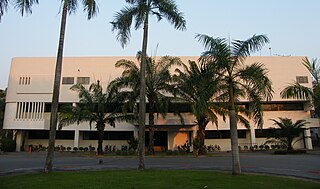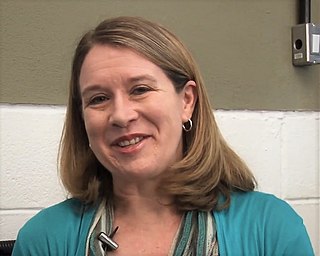
Nanomaterials describe, in principle, chemical substances or materials of which a single unit is sized between 1 and 100 nm.
A "photoelectrochemical cell" is one of two distinct classes of device. The first produces electrical energy similarly to a dye-sensitized photovoltaic cell, which meets the standard definition of a photovoltaic cell. The second is a photoelectrolytic cell, that is, a device which uses light incident on a photosensitizer, semiconductor, or aqueous metal immersed in an electrolytic solution to directly cause a chemical reaction, for example to produce hydrogen via the electrolysis of water.

In chemistry, photocatalysis is the acceleration of a photoreaction in the presence of a photocatalyst, the excited state of which "repeatedly interacts with the reaction partners forming reaction intermediates and regenerates itself after each cycle of such interactions." In many cases, the catalyst is a solid that upon irradiation with UV- or visible light generates electron–hole pairs that generate free radicals. Photocatalysts belong to three main groups; heterogeneous, homogeneous, and plasmonic antenna-reactor catalysts. The use of each catalysts depends on the preferred application and required catalysis reaction.
The impact of nanotechnology extends from its medical, ethical, mental, legal and environmental applications, to fields such as engineering, biology, chemistry, computing, materials science, and communications.
As the world's energy demand continues to grow, the development of more efficient and sustainable technologies for generating and storing energy is becoming increasingly important. According to Dr. Wade Adams from Rice University, energy will be the most pressing problem facing humanity in the next 50 years and nanotechnology has potential to solve this issue. Nanotechnology, a relatively new field of science and engineering, has shown promise to have a significant impact on the energy industry. Nanotechnology is defined as any technology that contains particles with one dimension under 100 nanometers in length. For scale, a single virus particle is about 100 nanometers wide.
Green nanotechnology refers to the use of nanotechnology to enhance the environmental sustainability of processes producing negative externalities. It also refers to the use of the products of nanotechnology to enhance sustainability. It includes making green nano-products and using nano-products in support of sustainability.
The Faculty of Engineering is a constituent body of the University of New South Wales (UNSW), Australia. UNSW was formed on 1 July 1949, and the Faculty was established on 8 May 1950 with the inaugural meeting of the Faculty taking place on 7 June 1950. It was one of the first three University faculties which were established by Council, and was initially formed of four departments including Electrical Engineering, Mechanical Engineering, Civil Engineering and Mining Engineering, headed by Dean Professor Harold Brown.
Amanda Susan Barnard is an Australian theoretical physicist working in predicting the real world behavior of nanoparticles using analytical models and supercomputer simulations and applied machine learning. Barnard is a pioneer in the thermodynamic cartography of nanomaterials, creating nanoscale phase diagrams relevant to different environmental conditions, and relating these to structure/property maps. Her current research involves developing and applying statistical methods and machine/deep learning in nanoscience and nanotechnology, and materials and molecular informatics. In 2014 she became the first person in the southern hemisphere, and the first woman, to win the Feynman Prize in Nanotechnology, which she won for her work on diamond nanoparticles.

The Center of Excellence (CoE) in Nanotechnology is located at the Asian Institute of Technology campus. It is one of the eight centers of excellence in Thailand.
Martina Heide Stenzel is a Professor in the Department of Chemistry at the University of New South Wales (UNSW). She is also a Royal Australian Chemical Institute (RACI) University Ambassador. She became editor for the Australian Journal of Chemistry in 2008 and has served as Scientific Editor and as of 2021, as Editorial Board Chair of RSC Materials Horizons.

Eugenia Eduardovna Kumacheva is a University Professor and Distinguished Professor of Chemistry at the University of Toronto. Her research interests span across the fields of fundamental and applied polymers science, nanotechnology, microfluidics, and interface chemistry. She was awarded the L'Oréal-UNESCO Awards for Women in Science in 2008 "for the design and development of new materials with many applications including targeted drug delivery for cancer treatments and materials for high density optical data storage". In 2011, she published a book on the Microfluidic Reactors for Polymer Particles co-authored with Piotr Garstecki. She is Canadian Research Chair in Advanced Polymer Materials. She is Fellow of the Royal Society (FRS) and a Fellow of the Royal Society of Canada (FRSC).
The health and safety hazards of nanomaterials include the potential toxicity of various types of nanomaterials, as well as fire and dust explosion hazards. Because nanotechnology is a recent development, the health and safety effects of exposures to nanomaterials, and what levels of exposure may be acceptable, are subjects of ongoing research. Of the possible hazards, inhalation exposure appears to present the most concern, with animal studies showing pulmonary effects such as inflammation, fibrosis, and carcinogenicity for some nanomaterials. Skin contact and ingestion exposure, and dust explosion hazards, are also a concern.

Titanium dioxide nanoparticles, also called ultrafine titanium dioxide or nanocrystalline titanium dioxide or microcrystalline titanium dioxide, are particles of titanium dioxide with diameters less than 100 nm. Ultrafine TiO2 is used in sunscreens due to its ability to block ultraviolet radiation while remaining transparent on the skin. It is in rutile crystal structure and coated with silica or/and alumina to prevent photocatalytic phenomena. The health risks of ultrafine TiO2 from dermal exposure on intact skin are considered extremely low, and it is considered safer than other substances used for ultraviolet protection.

Christy Lynn Haynes is a chemist at the University of Minnesota. She works at the interface of analytical, biological, and nanomaterials chemistry.
Lianzhou Wang is a Chinese Australian materials scientist and professor in the School of Chemical Engineering at the University of Queensland. He is director of the Nanomaterials Centre (Nanomac) and a senior group member at the Australian Institute for Bioengineering and Nanotechnology at the University of Queensland, as well as a Fellow of the Royal Society of Chemistry.
Emilie Ringe is an American chemist who is an assistant professor at the University of Cambridge. She was selected by Chemical & Engineering News as one of its "Talented Twelve" young scientists in 2021.
Mita Dasog is an associate professor at Dalhousie University in Nova Scotia, Canada. She has received the Emerging Professional Award, the Canadian Council of University Chemistry Chairs Doctoral Award, is a “Top 25” Global Young Scientist in Sustainable Research, and is one of the top 150 women in STEM for her outreach efforts with youth and young women.

Chuanyi Wang is a Chinese American, environmental chemistry scientist, academic, and an author. He is a Distinguished Professor and Academic Dean at the School of Environmental Science and Engineering at the Shaanxi University of Science & Technology. He is recognized for his research in environmental photocatalysis, environmental materials, surface/interface chemistry, nanomaterials, and pollution controlling.
Hala Zreiqat is a biomechanical engineer whose research focuses on the development of novel engineered synthetic materials and 3D printed platforms for regenerative medicine. She is a Payne-Scott Professor in the Department of Biomechanical Engineering at the University of Sydney.
Aibing Yu is a Chinese–Australian chemical engineer, serving as Pro Vice-Chancellor and Foundation President (Suzhou) at Monash University where he is also Sir John Monash Distinguished Professor Director of ARC Research Hub for Smart Process Design and BHP-Baowu-Monash Knowledge Centre for LCM.







